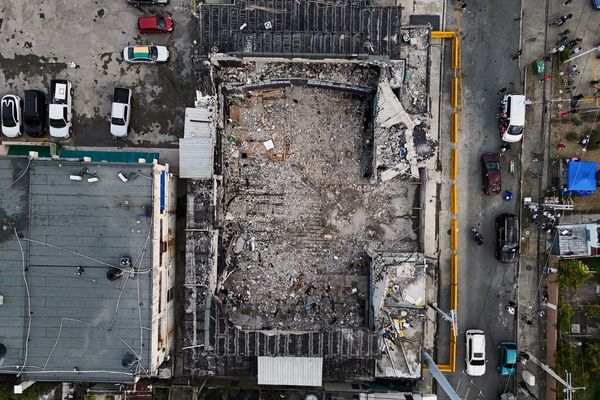
Myanmar is a south-east Asian country that has experienced decades of conflict and repressive military rule since it gained independence from Britain in 1948. Since a military coup in 2021, fighting has flared once again. Here’s a primer on the conflict:
What’s the history behind the current fighting?
Myanmar spent decades under military rule from 1962 to 2011, and was a pariah state subject to severe international sanctions. However, the country gradually began to liberalise and transition to a democracy. A nominally civilian government was introduced in 2011, and historic elections took place in 2015. National League for Democracy (NLD), the party of opposition leader Aung San Suu Kyi, who had spent years in prison during military rule, won the vote by a landslide. The military still retained significant political power, however, and in 2021 Myanmar’s transition towards democracy was cut short when it seized power in a coup.
What happened after the coup?
The coup was widely opposed by the public who took to the streets nationwide in mass protests. The military responded with deadly force, and began arresting anyone suspected of criticising its rule. In response, many civilians joined so-called people’s defence forces, to fight against it. Some ethnic armed groups, which have long fought for independence, also began fighting the military. These group’s specific goals, and the extent to which they are coordinated, varies. Fighting has spiralled across much of the country, including parts of the centre, which had rarely seen conflict in previous decades.
Who is winning and is there any likelihood of peace soon?
The sheer number of groups fighting against the military has left the generals severely overstretched. It has endured the most humiliating defeats in its history, losing huge swathes of territory including along the borders with China and Bangladesh. Dozens of towns and military battalions and even two regional commands have been lost.
A study by the BBC estimates the military controls just 21% of territory. The military has been accused of repeatedly bombing civilian sites, including schools and hospitals, torching villages, carrying out mass killings, and torturing its opponents in a desperate attempt to cling to power. Calls for the resignation of the junta chief Min Aung Hlaing have grown among pro-military circles, however he shows no signs of backing down.
The military has promised elections this year, but it is unclear how it will implement these given that large areas of the country are controlled by its opponents.
What are the US, EU and other countries saying or doing about it?
The US and EU have imposed a series of sanctions on figures and businesses linked to Myanmar’s military, however these have had little impact. The regional bloc, the Association of Southeast Asian Nations, has led international efforts to resolve the crisis, but with no success. It agreed upon a five-point concensus in 2021, which included a commitment to immediately end violence, and for constructive dialogue to find a peaceful solution. However, conflict has only escalated in the years since.
Which country has most influence over Myanmar?
China. It is an ally of, and supplies weapons to, the military but it also has ties with some of the powerful ethnic armed groups located near its shared border.
China’s response to the coup has shifted over time. Its initial response to the coup in 2021 was muted, but Beijing grew increasingly frustrated with the military’s inability to control the country, and especially its failure to clamp down on the criminal scam centres that proliferated in border areas and which targeted Chinese citizens. In 2023 it gave implicit approval for the Brotherhood Alliance, formed of armed ethnic organisations in the north, to launch an offensive against the military, in what many analysts believe was an attempt to punish the junta. However, when these groups launched a second offensive in 2024, and succeeding in taking even more territory, China put pressure on them to stop by cutting off border supplies, apparently concerned that the military could lose control of central cities. Since then, it has been more supportive of the military.
China will look to protect its interests in Myanmar, said Yun Sun, director of the China Program at the Stimson Center: “Border stability, investment, connectivity projects, and keeping Americans out.”
Who are the Rohingya and why are they so badly affected by this conflict?
The Rohingya are a Muslim ethnic minority group who have lived for centuries in Myanmar. Despite this, they are not recognised as an official ethnic group and have been denied citizenship since 1982, making them the world’s largest stateless population, according to the UN. The Rohingya crisis escalated dramatically in August 2017 when, in response to small attacks by a Rohingya armed group, the military conducted deadly “clearance operations” that drove more than 700,000 Rohingya across the border to seek safety in Bangladesh. The events led to allegations of genocide in the UN’s top court.
For the estimated 600,000 Rohingya remaining in Myanmar the situation is especially dire. They are now caught between the military and its opponent in Rakhine state, the Arakan Army (AA), which has taken control of much of the state. Rohingya say they have been subject to forced recruitment by the junta, as well as deadly attacks by the AA, which has accused them of siding with the military.
What happened to Aung San Suu Kyi?
Aung San Suu Kyi is Myanmar’s most famous politician. Born in Myanmar, which was then Burma under British rule, in 1945, she was the daughter of Myanmar’s independence hero, Gen Aung San. She went to the University of Oxford, then worked at the UN for three years, before marrying British historian Michael Aris in 1972.
After moving back to Myanmar in 1988, Aung San Suu Kyi became swept up in pro-democracy demonstrations opposing the ruling junta. In 1988 she co-founded the NLD, and was placed under house arrest the following year, where she remained on-and-off for 15 years. Globally, she was hailed as an icon for peace and democracy, and was awarded the Nobel peace prize in 1991. When Myanmar eventually held elections in 2015, the NLD won a sweeping victory. Aung San Suu Kyi was prevented from becoming president by a clause in the constitution, but became state counsellor.
Internationally her reputation suffered hugely when she failed to condemn the military’s brutal violence against the Rohingya minority. She remained highly popular domestically, however.
She was detained again in February 2021, after the military coup
Why did Myanmar change its name from Burma?
In 1989 the ruling military junta changed the country’s name to Myanmar, saying “Burma” was a hangover from colonial times that favoured the majority Burmar ethnic group. At the time, pro-democracy activists opposed the change, which they said the unelected junta had no authority to make. The change was also disingenuous, given the military’s repressive treatment of minorities. Countries and media were for years divided over which name to use; Burma was associated with the pro-democracy movement, while using the name Myanmar suggested approval of the junta. Now use of Myanmar is widespread.







